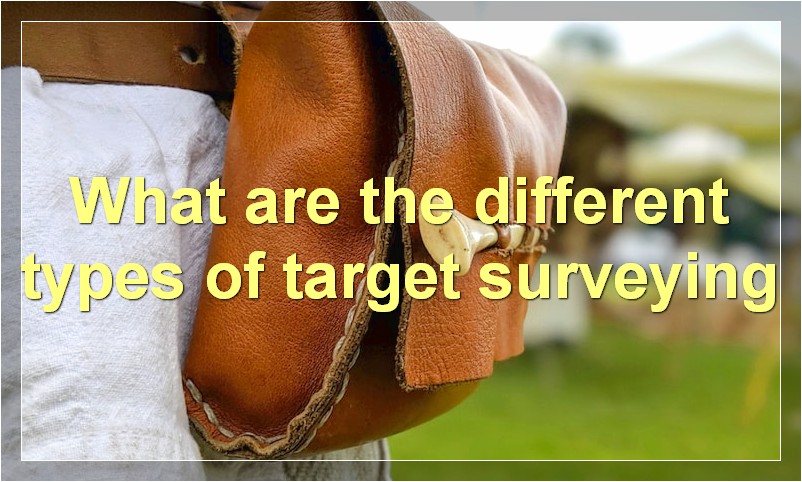Target Surveying is the superior surveying method when compared to traditional surveying methods.
What is the difference between target surveying and traditional surveying methods
Target surveying is a surveying method that uses a target to measure the distance between two points. Traditional surveying methods, such as tape measurements or laser measurements, are not as accurate as target surveying.
Target surveying is more accurate because it takes into account the curvature of the earth. When you are measuring the distance between two points with a tape measure, you are only measuring the straight-line distance between those two points. However, the earth is not flat, so the straight-line distance is not always the shortest distance between two points.
Target surveying is also more efficient than traditional surveying methods. With traditional methods, you have to take multiple measurements from different angles in order to get an accurate reading. With target surveying, you only need to take one measurement from one angle.
If you are looking for the most accurate and efficient way to survey a piece of land, target surveying is the way to go.
How does target surveying improve accuracy and efficiency
Target surveying is a process that uses special equipment to take measurements of a target area. This process can improve accuracy and efficiency by allowing surveyors to take more precise measurements and by reducing the need for manual labor. Target surveying can also help to save time and money by reducing the need for repeated surveys.
What are the benefits of using target surveying in construction projects
There are many benefits to using target surveying in construction projects. Target surveying can help reduce the overall cost of a project by reducing the need for expensive survey equipment and manpower. It can also help speed up the construction process by allowing construction crews to more accurately locate underground utilities and other obstacles. Additionally, target surveying can help improve safety on a construction site by providing crews with a better understanding of the layout of the site.
What are the disadvantages of using target surveying
There are a few disadvantages to using target surveying that should be considered before deciding if this type of surveying is right for a project. One disadvantage is that target surveying is time consuming and labour intensive. This means that it can be costly to hire the necessary personnel and equipment to carry out the survey. Additionally, target surveying is not always accurate, especially over long distances. This can lead to errors in the data collected which can then impact the accuracy of the final survey results.
How does target surveying work
Target surveying is a process that allows businesses to collect data about their target market. This information can be used to create marketing campaigns that are more effective and to better understand the needs of the target market.
There are a number of different ways to collect data for target surveying. Businesses can use online surveys, focus groups, and interviews to gather information. They can also use demographic information from public records and consumer data from market research firms.
Once the data has been collected, it needs to be analyzed in order to be useful. Businesses will look at factors such as age, income, gender, location, and interests when determining who their target market is. They will also look at what type of product or service the target market is interested in.
After the target market has been identified, businesses can create marketing campaigns that are specifically designed for that group of people. This allows businesses to use their resources more efficiently and to reach their target market more effectively.
What are the different types of target surveying
There are four main types of target surveying: Static, Kinematic, Relative and Absolute. Each type has its own advantages and disadvantages, so it’s important to choose the right one for your project.
Static surveying is the most basic type of surveying. It involves taking measurements at a single point in time. This means that any changes that occur between measurements will not be detected. Static surveying is best suited for projects where there is no movement, such as construction projects.
Kinematic surveying is more complex than static surveying. It involves taking measurements at multiple points in time, allowing for detection of movement. This type of surveying is best suited for projects where there is expected movement, such as monitoring a landslide or tracking the movement of a glacier.
Relative surveying is the most complex type of surveying. It involves taking measurements from two or more points in space and then calculating the relative position of each point. This type of surveying is best suited for projects where accuracy is critical, such as mapping a city or measuring the distance between two objects in space.
Absolute surveying is the most accurate type of surveying. It involves taking measurements from a fixed point in space and then calculating the absolute position of each point. This type of surveying is best suited for projects where accuracy is critical, such as mapping a city or measuring the distance between two objects in space.
What are the applications of target surveying
There are many applications for target surveying, from determining the best location for a new business to monitoring environmental conditions. By taking measurements and analyzing data, surveyors can provide valuable information that can help make informed decisions.
Some of the most common applications for target surveying include:
1. Determining the best location for a new business: By conducting a target survey of a potential site, businesses can get an idea of the traffic patterns, demographics, and other factors that can impact their bottom line.
2. Monitoring environmental conditions: Target surveys can be used to monitor changes in land use, water quality, and other environmental factors. This information can be used to make decisions about land management and conservation efforts.
3. Assessing property value: When considering the purchase or sale of property, target surveys can provide accurate information about the property’s value.
4. Planning construction projects: Before starting any construction project, target surveys are often conducted to assess the feasibility of the project and to develop a plan of action.
5. Checking the accuracy of maps: Since target surveys involve taking measurements and comparing them to known points, they can be used to check the accuracy of maps. This is especially important for maps that will be used for navigation purposes.
What are the limitations of target surveying
Target surveying is a method used to estimate the size, shape, and location of a target object. This method has many limitations that make it difficult to obtain accurate results. The first limitation is the angle at which the target is viewed. The angle of view affects the size and shape of the target object that is seen. If the target is not perpendicular to the line of sight, the size and shape of the target will be distorted. The second limitation is the distance between the observer and the target. The further away the target is, the more difficult it is to estimate its size, shape, and location. The third limitation is atmospheric conditions. Poor visibility due to fog, rain, or snow can make it difficult to see the target, which will affect the accuracy of the survey.
What are the challenges involved in target surveying
The biggest challenge in target surveying is finding the target. This can be difficult if the target is small or hidden. Once the target is found, the next challenge is to get accurate measurements. This can be difficult if the target is moving or if there are obstacles in the way.
How can target surveying be improved
There are a few ways that target surveying can be improved. One way is to use a more sophisticated method of target selection. Another way is to use more accurate measurements. Finally, target surveying can be improved by using more reliable data sources.



